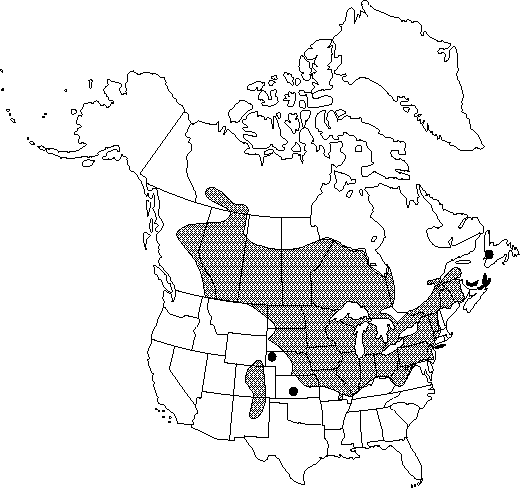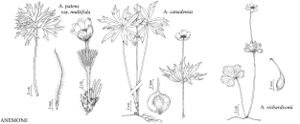Difference between revisions of "Anemone canadensis"
Syst. Nat. ed. 12, 3: 231. 1768.
FNA>Volume Importer |
FNA>Volume Importer |
||
| Line 34: | Line 34: | ||
|elevation=200-2800 m | |elevation=200-2800 m | ||
|distribution=Alta.;B.C.;Man.;N.B.;Nfld.;N.W.T.;N.S.;Ont.;P.E.I.;Que.;Sask.;Colo.;Conn.;Ill.;Ind.;Iowa;Kans.;Maine;Md.;Mass.;Mich.;Minn.;Mo.;Mont.;Nebr.;N.H.;N.J.;N.Mex.;N.Y.;N.Dak.;Ohio;Pa.;S.Dak.;Vt.;W.Va.;Wis.;Wyo. | |distribution=Alta.;B.C.;Man.;N.B.;Nfld.;N.W.T.;N.S.;Ont.;P.E.I.;Que.;Sask.;Colo.;Conn.;Ill.;Ind.;Iowa;Kans.;Maine;Md.;Mass.;Mich.;Minn.;Mo.;Mont.;Nebr.;N.H.;N.J.;N.Mex.;N.Y.;N.Dak.;Ohio;Pa.;S.Dak.;Vt.;W.Va.;Wis.;Wyo. | ||
| − | |discussion=<p>Various parts of Anemone canadensis were used medicinally by Native Americans in the treatment of wounds, nasal hemorrhages, eye problems, and sore throats, to counteract witch medicines, and as a general panacea (D. E. Moerman 1986).</p> | + | |discussion=<p>Various parts of <i>Anemone canadensis</i> were used medicinally by Native Americans in the treatment of wounds, nasal hemorrhages, eye problems, and sore throats, to counteract witch medicines, and as a general panacea (D. E. Moerman 1986).</p> |
|tables= | |tables= | ||
|references= | |references= | ||
| Line 58: | Line 58: | ||
|publication year=1768 | |publication year=1768 | ||
|special status=Endemic;Selected by author to be illustrated | |special status=Endemic;Selected by author to be illustrated | ||
| − | |source xml=https://jpend@bitbucket.org/aafc-mbb/fna-data-curation.git/src/ | + | |source xml=https://jpend@bitbucket.org/aafc-mbb/fna-data-curation.git/src/8f726806613d60c220dc4493de13607dd3150896/coarse_grained_fna_xml/V3/V3_571.xml |
|genus=Anemone | |genus=Anemone | ||
|species=Anemone canadensis | |species=Anemone canadensis | ||
Revision as of 17:18, 18 September 2019
Aerial shoots (15-)20-80 cm, from caudices on rhizomes, caudices ascending, rhizomes ascending to horizontal. Basal leaves 1-5, simple, deeply divided; petiole 8-22(-37) cm; leaf blade orbiculate, 4-10 × 5-15(-20) cm, base sagittate to nearly truncate, margins serrate and incised on distal 1/3-1/2, apex acuminate, surfaces puberulous (more so abaxially); segments primarily 3, lanceolate to oblanceolate; lateral segments again 1×-lobed or -parted (proximal lobe occasionally lobed again); ultimate segments 10-30(-35) mm wide. Inflorescences 1(-3+)-flowered, rarely cymes; peduncle puberulous to villous, distally densely villous; involucral bracts 3 (secondary involucres with 2), remotely subtending flowers, (1-)2-tiered, simple, ±similar to basal leaves, broadly obtriangular, 3-cleft, 3-10 cm, bases broadly cuneate, connate, margins sharply, irregularly serrate and incised on distal 1/3-1/2, apex acuminate, surfaces puberulous, more so abaxially; segments 3, lanceolate to oblanceolate; lateral segments unlobed or 1×-lobed; ultimate lobes (8-)10-15(-20) mm wide. Flowers: sepals (4-)5(-6), white, obovate, (8-)10-20(-25) × 5-15 mm, hairy or glabrous; stamens 80-100. Heads of achenes spheric to ovoid; pedicel 7.5-11.5 cm. Achenes: body obovoid to ellipsoid, (2.5-)3-6 × 3.5-6 mm, winged, strigose or glabrate; beak straight, 2-6 mm, strigose, not plumose. 2n=14.
Phenology: Flowering spring–summer (May–Aug).
Habitat: Damp thickets, meadows, wet prairies, lake shores, streamsides, clearings, occasionally swampy areas
Elevation: 200-2800 m
Distribution

Alta., B.C., Man., N.B., Nfld., N.W.T., N.S., Ont., P.E.I., Que., Sask., Colo., Conn., Ill., Ind., Iowa, Kans., Maine, Md., Mass., Mich., Minn., Mo., Mont., Nebr., N.H., N.J., N.Mex., N.Y., N.Dak., Ohio, Pa., S.Dak., Vt., W.Va., Wis., Wyo.
Discussion
Various parts of Anemone canadensis were used medicinally by Native Americans in the treatment of wounds, nasal hemorrhages, eye problems, and sore throats, to counteract witch medicines, and as a general panacea (D. E. Moerman 1986).
Selected References
None.
